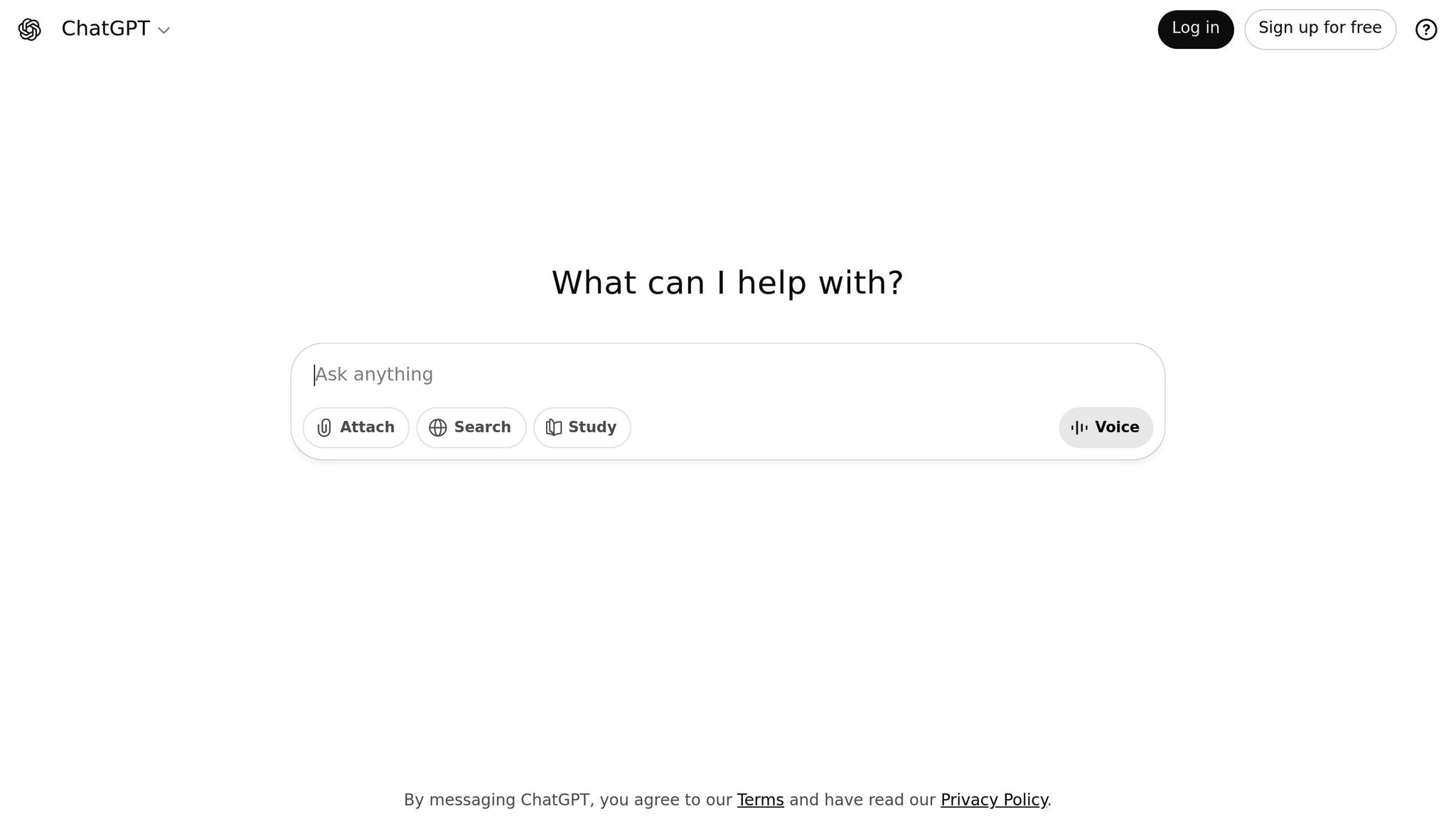
AI prompts simplify creating personalized content at scale. Instead of crafting messages manually, businesses can use these prompts to generate tailored recommendations, offers, and dynamic email content. The key to success lies in writing effective prompts that leverage customer data, such as purchase history, browsing behavior, and engagement patterns.
Here are the main areas where AI prompts can improve personalization:
God of Prompt offers over 30,000 ready-to-use AI prompts for tools like ChatGPT and Claude, helping businesses streamline content creation while maintaining a personal touch. Studies show that structured prompt libraries can boost productivity by 40% and improve user satisfaction by 67% within six months. Personalized content isn't just about technology - it's about making every customer feel valued.

Nailing product recommendations can make all the difference in creating a memorable shopping experience. The trick lies in using AI prompts to analyze customer behavior and preferences, surfacing items that align with their tastes while occasionally sparking curiosity.
Purchase History-Based Recommendations
One effective strategy is to dig into a customer's purchase history to suggest items that complement their previous buys. Instead of simply matching categories, the best prompts focus on uncovering patterns in their buying habits. For instance, a prompt could instruct the AI to: "Review the customer's last five purchases, identify recurring themes in terms of style, price point, and functionality, and recommend three products that align with these preferences. Additionally, include one option that introduces a new but related idea to encourage exploration."
This approach strikes a balance between offering familiar choices and introducing something new. For businesses looking to refine this strategy, God of Prompt's marketing bundle offers specialized prompts tailored for e-commerce personalization, compatible with platforms like ChatGPT and Claude. Adding insights from on-site behavior can make these recommendations even sharper.
Behavioral Pattern Recognition
Beyond purchase history, analyzing how customers interact with your site or app provides another layer of insight. By examining factors like browsing time, product views, cart activity, and seasonal trends, AI can predict what someone might want next. A sample prompt for this might be: "Based on the customer’s 15-minute session exploring outdoor gear, wishlist additions, and past spring purchases, generate five recommendations tailored to their outdoor lifestyle and seasonal interests."
What sets behavioral prompts apart is their ability to engage customers at the perfect moment in their buying journey. For example, if someone has been browsing camping gear for weeks, they’re likely ready for specific suggestions - like a particular tent or pair of hiking boots - rather than broad recommendations about outdoor gear. This precision can turn casual interest into a confident purchase.
Connect with your audience by tapping into their interests and how they consume content. AI prompts can take you beyond generic recommendations, helping you deliver articles, videos, and resources that feel tailored to each user.
The best content suggestions focus on what truly engages your audience. AI-powered prompts can analyze real engagement data to recommend content that's both relevant and appealing. For instance, a well-designed prompt might say: "Review this user's last 20 interactions - time spent reading, shares, and comments. Identify their top three interests and suggest five pieces of content that align with these, while introducing one new, complementary topic they haven't explored yet."
This method is especially effective for platforms with a wide range of content, like media outlets or educational hubs. The trick is balancing familiar topics that keep users engaged with fresh ideas that broaden their horizons. God of Prompt's comprehensive collection offers expertly curated prompts for tools like ChatGPT and Claude, making it easier to develop smarter content strategies. The most effective systems consider not just what users enjoy but also how they prefer to consume it - whether that's quick reads, in-depth articles, or visual formats. Matching the delivery style to the user’s preferences takes engagement to the next level.
Personalizing content delivery goes beyond choosing the right topics - it’s about how the content is presented. Some users love detailed, technical pieces, while others prefer quick, actionable summaries. A useful prompt might be: "Based on this user's engagement patterns and average reading time, adjust these recommendations to fit their preferred complexity level and format. Include estimated reading times and suggest the best delivery method - email, in-app notification, or social media."
Instead of sending a lengthy report to someone who prefers concise updates, AI can provide a condensed version or highlight the key points. For visual learners, the same content could be transformed into an infographic or video. By adapting the format to the user’s preferences, you can completely change how they interact with your content library.
Personalized offers take customer engagement to the next level by turning interest into actionable incentives. They go beyond generic promotions, tailoring deals to fit individual customer preferences and needs. This approach helps businesses connect with their audience on a deeper level, creating offers that feel relevant and timely.
The best promotions often stem from a customer’s past behavior. By analyzing purchase history, AI can identify patterns and craft offers that feel more natural and less intrusive. For example, a prompt might look like this: "Review the customer's past 12 months of purchases and seasonal trends. Create three offers: a complementary bundle, an upgrade, and a seasonal discount, each with specific timing and pricing details."
This method works especially well for e-commerce and subscription-based businesses. Instead of blanketing customers with the same generic discount, you could offer loyal buyers early access to new products or provide volume discounts to budget-conscious shoppers. Tools like God of Prompt's platform, designed for systems like ChatGPT and Claude, enable businesses to develop these tailored strategies. The real magic lies in understanding not just what customers purchase, but also when and why they make those decisions.
Real-time customer behavior, such as cart abandonment, repeated product views, or extended browsing sessions, offers valuable opportunities for targeted promotions. An effective AI prompt could be: "This user has revisited the same product category five times this week without making a purchase. Based on browsing patterns, price comparisons, and profile data, generate a time-sensitive offer with social proof and a compelling value proposition."
This approach helps capture customers when they’re most likely to act. For instance, someone repeatedly eyeing the same product might just need a small discount to seal the deal, while a shopper comparing multiple options might respond better to a detailed feature breakdown or glowing customer reviews. These targeted offers ensure that every customer interaction feels purposeful and relevant, increasing the likelihood of conversion.
Expanding on personalized product recommendations and content suggestions, dynamic email content takes things a step further by using AI to create highly customized messages for each subscriber. This approach tailors emails based on individual profiles and behaviors, leaving behind the outdated "one-size-fits-all" strategy.
The subject line is the gateway to your email - it’s your chance to make a great first impression. With AI, you can craft subject lines that speak directly to different audience segments. For example, you could use a prompt like this:
"Create five subject line variations using customer data, including preferences in communication style, recent browsing activity, and optimal send times."
This method works best when you factor in details like where the customer is in their lifecycle, how they’ve interacted with past emails, or even seasonal trends. For instance, a long-time customer who often opens promotional emails might respond well to something exclusive, like "Your VIP Access Awaits." Meanwhile, a budget-conscious shopper might be drawn to a direct value pitch, such as "Save Big on Your Favorites." God of Prompt's comprehensive toolkit offers specialized prompts for email marketing, making it easier to craft subject lines that connect with each recipient on a personal level.
While an engaging subject line grabs attention, the email body needs to deliver a seamless, personalized experience. AI can help you build dynamic content blocks that adapt to each recipient’s preferences. A useful prompt for this might be:
"Generate three content sections for this email campaign: a personalized product showcase based on browsing history, a tailored blog post recommendation matching their interests, and a call-to-action aligned with their buying stage."
This approach lets you create emails that feel uniquely tailored to each subscriber without losing your brand’s voice or focus. For instance, a new subscriber might receive educational content and gentle product introductions, while a loyal customer could see advanced tips or exclusive offers. The secret lies in not just deciding what to include, but also in structuring and presenting that content in a way that feels natural and meaningful to the recipient.
Behavior-triggered responses take personalization to another level by reacting instantly to customer actions. Instead of waiting for the next scheduled campaign, this method ensures your content evolves in real time, creating a more fluid and engaging experience.
When it comes to personalized email strategies, behavior-triggered responses shine during critical moments like cart abandonment. If a customer adds items to their cart but doesn't complete the purchase, AI can step in with tailored recovery messages that address their specific concerns.
For instance, a helpful prompt for crafting these emails might be:
"Generate a three-part recovery sequence: focus on price sensitivity in the first email, highlight product benefits and social proof in the second, and include a time-sensitive incentive in the third."
The key is understanding why the customer left. If they were comparing prices, a message emphasizing value or discounts might resonate. On the other hand, if they browsed multiple product pages, detailed explanations of features or benefits could be more effective. God of Prompt's marketing prompt library offers templates specifically designed for cart abandonment, helping you create recovery sequences that feel thoughtful and relevant rather than overly aggressive.
Behavior-triggered responses aren't limited to emails - they can transform live website interactions too. Real-time content adaptation allows you to tailor your site’s messaging, product recommendations, or even chat responses based on what users do in the moment.
A practical example of this in action could be:
"Generate adaptive content blocks based on time spent on a page, scroll depth, and clicks, with variations for quick browsers, in-depth researchers, and price-sensitive shoppers."
This approach is particularly effective for product and landing pages. By analyzing user behavior, you can tweak messaging to match their level of engagement. Whether someone is casually browsing or deeply researching, this strategy can turn passive interest into active participation, making every interaction feel personal and relevant.
Personalizing content has become a cornerstone of modern engagement strategies, and AI prompts are at the heart of making these experiences truly resonate. From customized product suggestions to responses triggered by specific behaviors, the methods we've discussed illustrate how well-crafted prompts can transform generic messaging into interactions that feel personal and meaningful. And the numbers back this up.
Studies show that structured prompt libraries can lead to a 40% boost in productivity, save 15–30 minutes per prompt, speed up AI adaptation and campaign development by 67%, improve content quality by 43%, enhance brand consistency by 89%, reduce revision cycles by 34%, increase AI output quality by 45%, and elevate user satisfaction by 67% within six months.
God of Prompt harnesses this potential with its extensive collection of over 30,000 AI prompts. These curated bundles, tailored for platforms like ChatGPT, Claude, Midjourney, and Gemini AI, eliminate the hassle of creating prompts from scratch, allowing you to focus on the bigger picture - your strategy.
But at its core, content personalization is about more than just technology. It’s about fostering real connections. AI prompts make it possible to scale these connections, ensuring every customer feels seen and valued. With a strong prompt library and a commitment to continuous improvement, you can shift from generic communication to dynamic personalization, driving deeper engagement, higher conversions, and lasting loyalty.
AI prompts play a key role in creating personalized product recommendations by analyzing data like demographics, browsing patterns, and purchase history. When prompts are crafted with individual preferences in mind, they can deliver suggestions that feel relevant and appealing to each customer.
For the best results, prompts should have clear goals and target specific customer groups. This strategy helps make recommendations feel more personal and engaging, which can boost sales and enhance customer satisfaction. Well-thought-out prompts can turn shopping into a smoother, more enjoyable experience for users.
To craft content suggestions that truly connect with your audience, start by using AI-powered data analysis to dig into user behavior, preferences, and habits. This data can help you create recommendations that feel personal and aligned with what individuals actually care about.
Consider applying the 4 D’s of personalization - Data, Decisioning, Delivery, and Design - to build a well-rounded strategy. Incorporate dynamic content formats, like interactive features or visually engaging elements, to capture attention. And don’t stop there - keep fine-tuning your recommendations based on user feedback to ensure they stay fresh and relevant.
AI-driven personalized offers are transforming how businesses engage with their customers, crafting experiences that align closely with individual preferences. Research highlights that consumers are far more likely to interact with brands that use AI to deliver customized recommendations and deals.
This tailored approach doesn’t just make the customer journey more enjoyable - it has a direct impact on boosting conversion rates. By matching offers to specific behaviors and needs, companies can see a clear rise in engagement and sales, paving the way for measurable growth across the board.







